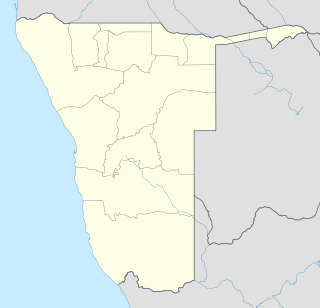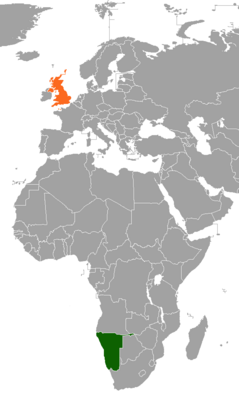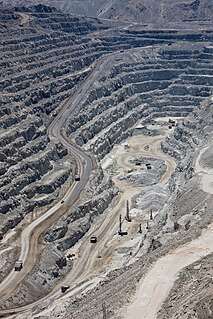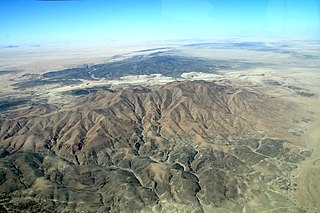The Urenco Group is a nuclear fuel company operating several uranium enrichment plants in Germany, the Netherlands, United States, and United Kingdom. It supplies nuclear power stations in about 15 countries, and states that it had a 29% share of the global market for enrichment services in 2011. Urenco uses centrifuge enrichment technology.

The Rössing Uranium Mine in Namibia is the longest-running and one of the largest open pit uranium mines in the world. It is located in the Namib Desert near the town of Arandis, 70 kilometres from the coastal town of Swakopmund. Discovered in 1928, the Rössing mine started operations in 1976. In 2005, it produced 3,711 tonnes of uranium oxide, becoming the fifth-largest uranium mine with 8 per cent of global output. Namibia is the world's fourth-largest exporter of uranium.

The McArthur River Uranium Mine, in northern Saskatchewan, Canada, is the world's largest high-grade uranium deposit.

Trekkopje is a mountain in the Erongo Region of Namibia, c. 85 kilometres (53 mi) north-east of Swakopmund on the road to Usakos.
Paladin Energy Ltd is a Western Australian based uranium production company.

Arandis, Namibia is a town in Erongo Region, Namibia. It has been called the Uranium Capital of the World as it is located just 15 km outside the world's largest open-pit uranium mine, the Rössing Uranium Mine. From Khoekhoegowab, 'the place where people cry'.

Mining is the biggest contributor to Namibia's economy in terms of revenue. It accounts for 25% of the country's income. Its contribution to the gross domestic product is also very important and makes it one of the largest economic sectors of the country. The majority of revenue comes from diamond mining.

The uranium mining debate covers the political and environmental controversies of the mining of uranium for use in either nuclear power or nuclear weapons.

Namibia–United Kingdom relations refers to the bilateral relationship between Namibia and the United Kingdom. Relations are considered good and the British Council operates in Namibia. In 2013 Steve Katjiuanjo became Namibia's High Commissioner in London. The mission is accredited to Cyprus, Greece, Ireland and Malta as well as multilateral organizations based in London. Since January 2018, Kate Airey has been the High Commissioner of the United Kingdom to Namibia.

Namibia is an arid country that is regularly afflicted by droughts. Large rivers flow only along its Northern and Southern border, but they are far from the population centers. They are also far from the country's mines, which are large water users. In order to confront this challenge the country has built dams to capture the flow from ephemeral rivers, constructed pipelines to transport water over large distances, pioneered potable water reuse in its capital Windhoek located in the central part of Namibia, and built Sub-Saharan Africa's first large seawater desalination plant to supply a uranium mine and the city of Swakopmund with water. A large scheme to bring water from the Okavango River in the North to Windhoek, the Eastern National Water Carrier, was only partially completed during the 1980s.

Uranium mining in Namibia is of considerable importance to the national economy. In 2011, Namibia was ranked as the 4th largest producer of uranium worldwide, behind Kazakhstan, Canada, and Australia. When Uranium prices fell after the Fukushima incident production was reduced. In 2012, Namibia produced 7.1% of Uranium oxide worldwide, trailing behind Niger as well.
The country mining the largest amount of uranium is Kazakhstan, which in 2017 produced 39% of the world's mining output. Canada was the next largest producer with a 22% share, followed by Australia with 10%. There are uranium mines on every inhabited continent.
Nuclear energy in Namibia is a topic of geopolitical interest but is currently not an infrastructure concern. There are no nuclear power plants in Namibia. There is potential interest in the country's nuclear power capacities, as Namibia is the world's fourth-largest uranium producer.

The Langer Heinrich mine (LHM) is a large open pit mine located in the western part of Namibia in the Erongo Region. Langer Heinrich represents one of the largest uranium reserves in Namibia having estimated reserves of 57,000 tonnes of ore grading 0.055% uranium. The Langer Heinrich mine is currently owned by Paladin Energy Ltd with a 75% stake and CNNC Overseas Uranium Holding Ltd with a 25% stake. Paladin Energy sold the 25% to the Chinese National Nuclear Corporation (CNNC) in 2014 for a reported $190 million.

The Norasa uranium project comprises the Valencia and Namibplaas deposits in Erongo Region in the western part of Namibia. The two parts are 7 kilometres (4.3 mi) apart and both are fully owned by Forsys Metals. It represents one of the largest uranium resources in Namibia, having an estimated resource of 48,200 tU in ore grading 0.014-0.0167% uranium. The Valencia deposit was named after the farm where the uranium deposits were found.
The Etango mine is a proposed open pit mine located in the western part of Namibia in Erongo Region. Etango represents one of the largest uranium reserves in Namibia, having estimated reserves of 46,000 tonnes of Uranium in 455.7 million tonnes of ore grading 0.0165% uranium.
The Reptile project is an exploratory development of uranium deposits in the Erongo Region of western of Namibia run by Deep Yellow Limited. It includes prospecting areas known as Tubas-Tumas and Tubas Red Sand. Tubas-Tumas has estimated reserves of 22.7 million tonnes of ore grading 0.03% uranium. Tubas Red Sand has estimated reserves of 90.8 million tonnes of ore grading 0.012% uranium.

The Husab Mine, also known as the Husab Uranium Project, is a uranium mine under development near the town of Swakopmund in the Erongo region of western-central Namibia. The mine is located approximately 60 kilometres (37 mi) from Walvis Bay. The Husab Mine is expected to be the second largest uranium mine in the world after the McArthur River uranium mine in northern Saskatchewan, Canada and the largest open-pit mine on the African continent. The Husab Mine started production towards the end of 2016 after completion of the sulfuric acid leaching plant.
Orano SA is a multinational nuclear fuel cycle company headquartered in Châtillon, Hauts-de-Seine, France. The company is engaged in uranium mining, conversion-enrichment, spent fuel recycling, nuclear logistics, dismantling, and nuclear cycle engineering activities. It was created in 2017 as a result of restructuring and recapitalizing of the nuclear conglomerate Areva. Orano is majority owned by the French state.










